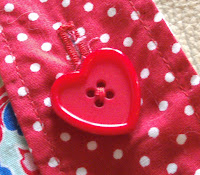I now live in an area where craft fairs, farmer's markets and the like have a very different demographic to my last home.
So some time ago I decided to change my focus from designer dolly clothes to something else, and see how it goes, for a time at least. But change it to what?
I was strolling through a local town -
not one of the more prosperous ones, though - and in a very traditional hardware shop I saw an apron, a rather 'old-fashioned' apron by my standards, but clearly an on-trend. highly-desirable retro-style apron by the standards of the three young women who were admiring it.
Its price?
£85
Yes, you read that correctly. There was a whole rack of them in the shop. I say '
was' because the rack is now empty and those who enquire are told there are, it seems, 'no more to be had'.
EIGHTY FIVE POUNDS!!!
What the hell, I thought, I'll make a couple and see what my much younger, much more 'trend-aware' friends think of them.
 |
| Retro-style apron |
So I did.
Heck, I've been sewing for well over 50 years - everything from ball gowns to horse rugs via curtains, dog-clothes and christening robes - so a retro-style apron held no fears for me.
The main fabric was a chance find in Abakhan's bargain bins some time ago; the piece was about 3m long and cost me under £10. It's a 'Timeless Treasures' (USA) design which sells for well over that price
per metre. I do like Abakhan's (well, the Manchester branch anyway - more on that another time)!
It's pure cotton - 'quilting weight' according to Timeless Treasure's website - and was a pleasure to handle and make up. The red spot used for the flounce, pocket binding and one side of the ties is also pure cotton, but a UK one, described as 'craft weight cotton'. It's as near identical in weight to the US quilting cotton as makes no matter, and was equally pleasant to work with. The red is an exact match to the red in the main print.
I was very happy with the result, and so are others - the apron pictured above was nabbed by an acquaintance who does farmer's markets (she's a baker and makes delicious yummy biscuits and cakes) and has been looking for a pretty, feminine,
cotton apron with decent coverage. This lady is tall - about 5ft 10" - and a size 18 in RTW. Her only criticism was that the waist ties are a little too short (which I thought they would be - I was being economical with fabric on my prototype). Otherwise, it fit perfectly. I too am a size 18 in RTW, but a totally different shape and considerably shorter; it fits perfectly. A teenager - 5ft 7", about a size 8 -10 - loved it and wants one 'exactly the same' as it fits perfectly. As the style doesn't bunch around the waist, it's flattering, too.
 |
| Cute button, or what? |
The neck-strap fastens with these cute heart-shaped buttons; there are two buttonholes on each end of the strap so it's really very adjustable.
Oh, and I forgot to mention that it's fully lined - with another vintage-style cotton print, sourced from Immanuel Fabrics.
 |
| Waist-tie, bound pocket-top and lining. |
See!
The lining fabric is so nice that it makes the apron fully reversible (except it doesn't have pockets on the reverse).
It's such a horrid day today that photography was difficult to say the least, but I hope you get the general effect.
I've got another three aprons 'on the go' - all using the same basic template, but with differences in trim, and with three very different fabrics and colours. It's not fit for a cat to be out today - my kitten looked at the weather for a moment then came back inside and used her litterbox - and half my garden has blown over the other half, but there's nothing I can do about it until the wind drops, so I may as well get on with my sewing.




